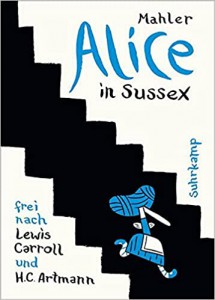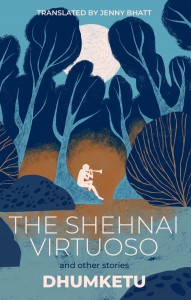In this month’s round-up of exciting new translations from around the world, our editors review an artful and intertextual graphic novel from Nicolas Mahler; a lyrical, genre-bending tale of creation and storytelling from Spanish writer Manuel Astur; and a compilation from Gujarati writer Dhumketu, a master of the short story. Read on to find out more!

Alice in Sussex by Nicolas Mahler, translated from the German by Alexander Booth, Seagull Books, 2022
Review by Charlie Ng, Editor-at-Large for Hong Kong
Lewis Carroll’s Alice and Frankenstein’s monster make an unlikely combination, but in Alice in Sussex, Austrian comic artist and illustrator Nicolas Mahler brings the two together in his vivid reimagining of a classic tale. The title of the graphic novel makes references to both Alice’s Adventures in Wonderland and H. C. Artmann’s parody of Mary Wollstonecraft Shelley’s Frankenstein—Frankenstein in Sussex, suggesting an intertextual playfulness that is further substantiated throughout the work. Mahler’s seven-year-old Alice—the same age as Carroll’s—experiences an adventure as equally nonsensical as the original’s, but her journey is even more rife with complexities, incorporating a wide range of literary and philosophical references. To sum it up, this adventure down the White Rabbit’s hole is a humorous, inventive set, in which Mahler can play with his own literary and philosophical influences.
Readers familiar with Alice’s Adventures in Wonderland can certainly remember the beginning of the children’s classic, in which Alice complains that there are no pictures or conversations in her sister’s book. Mahler’s Alice encounters the same boredom when reading her sister’s copy of Frankenstein in Sussex, and thus initiates the White Rabbit’s invitation into his hole, promising to show her “a lavishly illustrated edition.” Drawn sitting by an infinity-shaped stream, the waters foreshadow Alice’s seemingly never-ending descent down the chimney into a huge house underneath the meadow, as well as the long, elaborated, and bizarre dream that follows. Although the promised book cannot be found on the Rabbit’s bookshelf, the graphic novel actualises it—illustrating Alice’s encounter with Frankenstein’s monster later in the story. It also tries to acknowledge her other desire—for conversations—by letting her meet and converse with other idiosyncratic characters. Both, however, turn out to be anything but desirable for young Alice.
In Lewis Carroll’s original, Alice ponders on her identity after experiencing a series of queer events: “Who in the world am I? Ah, that’s the great puzzle!” Likewise, Mahler’s Alice is confronted with the same crisis, visually represented by Alice falling into the huge, fuzzy cloud of smoke drifting from the pipe of the Caterpillar, who then asks her: “Who are you?” Alice is unable to answer the question, but she also doesn’t make any great effort; her desire to escape is stronger than any liking for strange conversations. A further existentialist twist is introduced when the White Rabbit can only find The Trouble with Being Born by Romanian philosopher Emil Cioran on his bookshelf, and the Caterpillar tells Alice an important thing about life: “Being alive means losing the ground beneath your feet!!!” Such aphorisms are commonly sprinkled throughout the graphic novel—reminiscent of The Trouble with Being Born; the pain of life is treated with levity and amusement, with Alice being tossed around on the Caterpillar’s body, and the Caterpillar’s writhing shifts with his many legs in the air. While Alice is dismayed at losing the ground beneath her feet, the Caterpillar is comfortable with it. Despite being infused with dark humor, Mahler’s style is never overly harsh on his characters; his drawings are delightful, exuding a sense of gentleness.
Such a reimagining of the classic shows a strong awareness of the unstable boundaries in writings for children—exemplified by the Alice books and Artmann’s Frankenstein in Sussex—as well as the invalidity of stereotypical divisions between children and adult experiences. When the White Rabbit finds another book, Against Youth by the Belgian writer Robert Poulet, he claims that it is “the cult book of my old man” and reads from it: “A child’s day: a chain of horrific dramas, each of which would ruin an adult . . .” The quote precisely undermines the impression of childhood innocence, suggesting that anxiety and pressure of life is not exclusive to grown people. The White Rabbit displays an easiness in coping with life in the house, claiming it as “a magnificent house in the best of all possible worlds.” The baffled and impatient Alice disagrees—their difference is not simply because the Rabbit belongs to “this world” and Alice “the other,” but also that the well-read Rabbit is a philosopher who can contain the existential nature of life in abstractions, while Alice remains vulnerable to its nonsense and absurdity.
The Rabbit, as well as the other enigmatic characters in the story—the Cheshire Cat who says everyone is mad, the Mouse who tells a long story of himself by parodying Melville’s Moby Dick, the Mad Hatter who is obsessed with riddles, and the Mock Turtle who tells Alice his school schedule—all serve to reflect the author’s literary and philosophical influences, even incorporating a bit of Mahler’s own qualities. The proliferate quotes and intertextual allusions speak to the new lives that texts take on once they are released to the greater world, seemingly adulating the ability of the individual imagination to transform words and meanings. When Alice finally meets Frankenstein’s monster (instead of the Queen), a metafictional moment follows, in which Mrs. Mary Wollstonecraft Shelley discusses with Frau Holle about the monster and Alice: “Do you really think that this creature of my imagination would like to do harm to that of Mr. Carroll’s?”
As a young girl, Alice is not impressed by the eccentric “friends” she comes across, feeling perturbed by the terrible dangers that nearly bring about her death in this nightmare. When she wakes up, she asks her sister: “I’d like to know what is worse . . . enduring all the terrible things that happened to me or staying here and doing nothing.” Mahler does not shy away from ascribing validity to a child’s terrors, but to admit that life is frightening—that sometimes we may even prefer nothingness—does not detract from the fact that growing up with the works of great writers and philosophers still makes this world the best of all possible worlds.

Of Saints and Miracles by Manuel Astur, translated from the Spanish by Claire Wadie, Peirene Press/New Vessel Press, 2022
Review by Olivia Roslansky, Social Media Manager
Multiple iterations of one line echo like a mantra throughout Manuel Astur’s Of Saints and Miracles, spoken by an omniscient fusion of voices:
We have the voice and we have the time. We have all time.
Evoking Borgesian undertones with its inventive, self-aware narration, Of Saints and Miracles oscillates between crime fiction, fable, fantasy, and realism. In a text addressing both eternity and the present, Astur merges the infinity of storybook mysticism and the limits of human existence, balancing out lyrical visions with conversational asides to the reader: “the fire is going out. More stories tomorrow.” Throughout this poetic and magical novel, we experience storytelling and oral tradition as ways of life and as life itself—be it in the intergenerational fables and myths that carry the identities of the Spanish countryside villagers, or the central meta-narrative of an impoverished farmer, wanted for possible murder. Stories, as we are told in the second part of this novel, are “more important than anything.”
The tale Astur tells around the fire of this work is the illustrative history of Marcelino, a farmer living in the Asturias, who, after engaging in a confrontation with his brother that results in bloodshed, flees into the countryside to evade persecution. Both born to the same abusive father, his brother is portrayed as a foil to Marcelino—a “thug”—while Marcelino remains a “saint,” becoming a revered fugitive to many. This deceptively simple premise, however, opens up to a vast range of histories and spaces, all branching out from the narrative linearity of Marcelino’s escape.
Cleverly toying with the fluidity of time and place as experienced by a body in constant motion, the author moves between Marcelino’s search for a rural idyll and the collective history of a rustic peoples, tied to their surroundings. Astur’s language is meticulous and vivid, evoking contours of river currents and mountain edges, and encouraging us to consider the myriad ways the fragmented pieces of our pasts come to forge our identities, whether likened to culture, politics, or most prominently, our physical landscapes. The relationships between humanity and nature are echoed in one of the text’s many fables of creation; in this world, the Moon is a child of the Oak Tree and the Sun, and the Moon a lover to the River. Together, they birthed a girl who created language, an ancestral one only tied to nature and its interconnectedness:
[W]ords would beget words, and would give thanks for the miracle of existence to the ones who’d come before. So a flower was an open hand; and an open hand a flower in the sun and the valley basin. So night was a closed flower; and a closed flower a clenched fist and a mountain.
The parallelistic syntax that marries the human body with the various physical bodies of nature embodies how the linguistic iterations of landscape underline this entire work; Astur poetically unearths the extent to which the natural world enables us to narrate ourselves, our fears, and our hopes. The lingering scars left by Marcelino’s father are recalled in descriptions of his father as “the black shadowless night.” The sea, too, becomes a sublime materialization of the constancy and cyclicality of Marcelino’s journey: “The earth was constantly owing and changing, and the sea, he imagined, was unchanging, solid, immense, permanent.”
As in any text that addresses its own textuality, one must read in that Barthesian way—vertically. Despite moving with the horizontal progression of Marcelino’s evasion of authority, Of Saints and Miracles continually and unconventionally demands our attention to detail. The polyphonic and authorial ‘narrator’—who seems to permeate the entirety of time—thrives in moments of jolting analepsis, opening a way for the reader to experience and reconcile with storytelling as something primeval and ever-present. The narrator compels the text through Marcelino’s childhood, the history of the countryside through the Spanish Civil War, and the beginning of time:
[W]e know all about miracles. We’ve been keeping a watchful eye for thousands of years and we’ve witnessed them all. Because if a miracle occurs and we’re not there to see it, it isn’t a miracle.
In exceptional precision of style, the text shifts from mellifluous to aphoristic and tangential tones (“What we grow upwards, we must also grow deep down. A tree without strong roots is destined to fall at the first gust of wind.”) while also moving the reader with unsettling and horrific depictions that break free from delicate portrayals of nature—visceral images of animal food preparations, an uncanny worm epidemic that local residents believe to be the Devil’s. The enthralling juxtapositions, from tone to genre, are deftly captured and powerfully enabled in Claire Wadie’s translation. As Astur’s English-language debut, Of Saints and Miracles is a mesmerizing introduction to the Spanish author’s oeuvre, illuminating his capacity to harness the power of language to materialize shared histories and immortalize identities:
He said he wanted to learn all the stories in the world so that he could tell them to whomsoever deserved to hear them, and live on in them forever.

The Shehnai Virtuoso and Other Stories by Dhumketu, translated from the Gujarati by Jenny Bhatt, Deep Vellum, 2022
Review by Andrea Blatz, Copy Editor
Dhumketu’s debut collection of short stories in English, The Shehnai Virtuoso and Other Stories, offers readers an up-close and personal view of India and its people in the early twentieth century. His wide range of subjects covers characters from all walks of life, from those living in poverty to royalty, and from people in remote areas all the way to the lively cities. Through this depth and breadth, the author sheds light on the sociocultural totems prevalent during his time—many that remain common today—via the intimate perspectives of individual lives, welcoming readers back to a slower time to unshroud the various, powerful details pervading the day to day.
Dhumketu—the nom de plume of Gaurishankar Govardhanram Joshi (1892–1965)—is one of the most prominent writers in the Gujarati language, mostly known today for his innovations of the short story. His oeuvre includes twenty-four story collections, as well as a number of novels, biographies, translations, and other works. In the introduction to his first collection, Dhumketu cites western authors such as Émile Zola, Rudyard Kipling, and Joseph Conrad as pivotal influences to both his work and the genre. Dhumketu explains what he believes the short story as a genre aims to accomplish, stating:
The short story is that which, like a flash of lightning, pierces right through while establishing a viewpoint; without any other machinations, simply gestures with a finger to awaken dormant emotions; creates an entirely new imaginary world around the reader. [. . .] The short story, by rousing the imagination and emotions, only alludes to or provides a spark of whatever it wants to say.
In other words, the author plants a seed in the reader’s mind, and only then will it blossom into a fully developed idea. It is up to the reader to extend the message of the story, using their own thoughts and experiences to exercise its full potentialities.
In her translation, Jenny Bhatt invites the reader into Dhumketu’s world as an expert guide; not only does her introduction draw a map—complete with instructions on how to understand its complexities—but she remains present throughout the text, conducting the reader through any unfamiliar history, culture, and language via footnotes and a glossary. Her choice of stories to include in this collection (at least one from each of the original compilations) are carefully intended to underline the scope of the author’s skill and knowledge of his country. The result is a kaleidoscope, abundant in variegating depictions of both landscapes and the human interiors populating them.
The collection begins with “The Post Office,” Dhumketu’s most well-known work. This story tells of a father waiting for a letter from his daughter, who had moved when she married a man in another town—a letter that ultimately comes too late. As an opener to the sequence, the author immediately shows us an intuitive ability to highlight both ends of the emotional spectrum: the joy of the man when recalling time spent with his daughter, and his sorrow when, day after day, no letter arrives.
In another work, “Unknown Helpers,” Dhumketu portrays the story of an anonymous man who moves through life with a sense of duty, filling in where and when he is needed. When a village needs a helping hand, he steps up without expecting praise; he also accepts blame for occurrences there when no one else does. One day, seeing a young woman of the “untouchable dhedh” caste being ill and harassed by the villagers, the anonymous man sits with her, helping her heal and giving her a moment of happiness. When the locals see him with her, however, they punish him by throwing stones. He accepts without complaint, explaining:
A person is drawn to a task by two tendencies: compassion or wisdom. If there is compassion in people, then stones won’t fall. If there is wisdom, there won’t be cruel laughter. To people, between reason and appearance, the latter is of more importance. He bore the assault quietly and went on.
Despite this noble deed, the villagers see his act as sinful; they are unable to break from the appearances their society relies upon. In this way, the story intones the resonances of a fable, hinting that one should focus on helping others rather than what others think. In addition to being a tale of morality, the story also allows Dhumketu to criticize the caste system, in which the villagers choose to cast out a kind, helpful man rather than reassess their biases.
Many of Dhumketu’s stories also focus on women; Bhatt explains: “he took care to portray his female protagonists as complex human beings in their own right.” In his tales, the thoughts and feelings of women are given room; they explore, desire, and act of their own volition—with sometimes surprising results. In “The Queen of Nepal,” Gopi falls in love with her neighbor, Dalbahadur, and they—both already married—make plans to run off together. On the night of their escape, however, Dalbahadur sees a play about the adulterous Sita and backs out of their plan at the last minute. Unfazed, Gopi leaves without him and sets up a tea house in the mountains, where she is known as “The Queen of Nepal.” A few years later, Dalbahadur shows up and informs Gopi that both her husband and his wife had died due to the war. Instead of taking the opportunity to be with Dalbahadur, however, Gopi leaves her tea house to be with her husband’s family, finally realizing that she did love him.
In each story, be it through the vibrant description of person or place, Dhumketu encourages his readers to look further at the small aspects of life and to appreciate the beauty that surrounds us. Even though many of the stories are nearly a century old, the themes remain relevant, charting the foundations of human existence through time, space, and language.
*****
Read more on the Asymptote blog:

